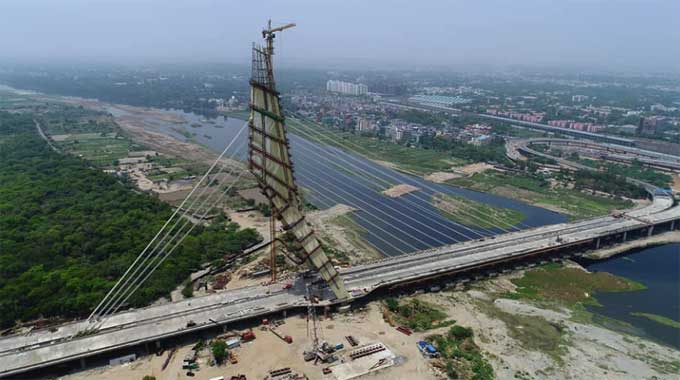
Building a Signature Bridge: Design, Foundations, Materials & Construction Problems

It is common for bridges to have a symmetrical shape to carry the entire bridge's weight, which further reduces the load on the foundation. Its Namaste shape expresses reverence and respect in Indian culture, a gesture of reverence and respect.
Signature Bridge Design
In total, the bridge measures approximately 575 meters in length, with the majority of its length being 251 meters. In New Delhi, the bridge is twice as tall as the Qutab Minar and has the highest elevation.
There are four lanes of dual carriageway with a total width of 14 meters. The elevated pylon with a height of 154 meters and luxury cable design create a stunning and imposing addition to the Delhi skyline.
To maintain and view the bridge pylon from the top, stairs and lifts are provided. Furthermore, a sophisticated structural health monitoring system is installed, which monitors the bridge's structural response to weather loading and earthquakes.
Signature Bridge Materials
Steel of grade S355J2 and steel of grade S355NL was utilized for the construction, with S355J2 steel with a thickness up to 80 mm and S355NL steel with a thickness over 80 mm. Steel was used in the fabrication of the pylon and deck to the extent of 6500 and 7000 metric tons.
A high quality steel grade was used to improve the deformation characteristics of a highly stressed zone line on the pylon and the base of the pylon. In the construction of foundations and decks, concrete grades ranging from M 40 to M 60 were used.
Signature Bridge Foundations
It is important to understand the details of the foundation of the Signature Bridge as follows: Because the profile of the rock bed beneath the bridge changes so drastically, the construction of the foundation was quite challenging. Bridge piers were prepared with open and well-prepared foundations.
It is composed of two large circular open foundations over which the bridge pylon is reinforced. The circular foundations have a diameter of approximately 23 meters. The foundation level was dug using specially designed sheet pile cofferdams with a toe pinning and bracing arrangement.
Signature Bridge Construction Process
The Signature Bridge consists of two main components: the pylon and the deck. Three-dimensional pylons are complicated three dimensional structures that are inclined in all directions. Panels of irregular shapes are bonded to steel plates of varying grades. Concrete and steel are used in the construction of the bridge's deck.
1. Due to the asymmetry of the Signature Bridge?s cable stayed structure, it was unstable during the erection process. In order to maintain the accuracy of geometry, specific reinforcements were designed.
2. To sustain the preliminary stage of pylon erection, a tie-down system was established at the base of the pylon. Additionally, a specially designed temporary support reinforced the pylon, and permanent cables were installed after the construction of the pylon.
3. For the erection of the pylon, a crawler crane with a capacity of 1250000 kg was used. In order to construct the deck girder, a Goliath gantry was used over a temporary horizontal beam braced with two pairs of sloping legs, as well as a temporary open braced framework.
Signature Bridge Construction Process
Pile Foundations Issues
The foundation was built on piles at the beginning of the project. Nevertheless, a detailed understanding of the soil revealed that there are unstable rock strata beneath the piers. As a result, the foundation design had to be modified.
Integrated pile foundations have been replaced with good foundations. As a result, the construction of the project was paused due to the change in foundation design. As a result of the lack of geotechnical survey done before implementation, the area suffered from earthquakes.
Soil Issues
For the unbalanced steel pylons, a large crane was required. As the Yamuna bank soil was low in bearing capacity and the crane had to move heavy loads, setting up the crane was problematic.
To learn more, watch the following video tutorial.
Video Source: Keep On Driving
Gantry Crane Issues
A gantry crane was used to raise and shift the precast elements. A giant storm in June 2016 affected the gantry cranes working, and it had to be redesigned and re-fabricated again. In this regard, the work was influenced until December 2016, which led to uncertainty in girder placement.
Over ten years after it was supposed to be constructed, the bridge has still not been completed due to a number of factors, including contractual problems and environmental clearance issues.


